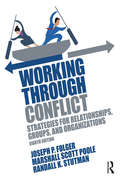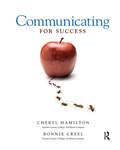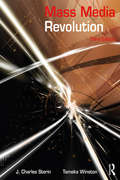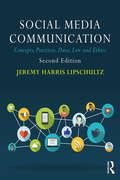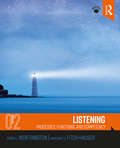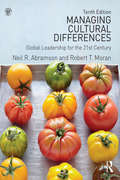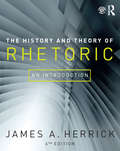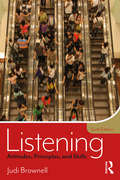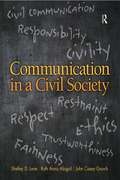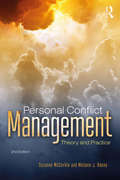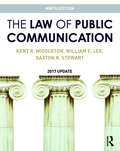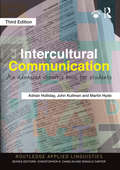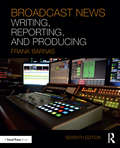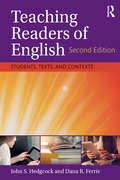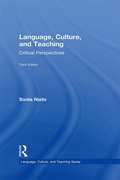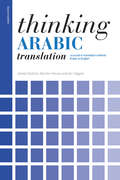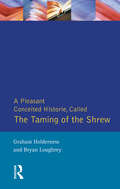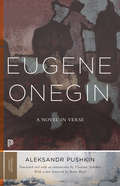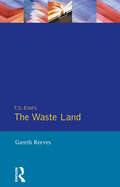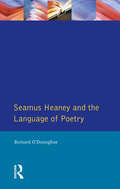- Table View
- List View
Working Through Conflict: Strategies for Relationships, Groups, and Organizations
by Joseph Folger Marshall Scott Poole Randall K. StutmanNow in its eighth edition, Working Through Conflict provides an introduction to conflict and conflict management that is firmly grounded in current theory, research, and practice, covering a range of conflict settings (interpersonal, group, and organizational). The text includes an abundance of real life case studies that encompass a spectrum of theoretical perspectives. Its emphasis on application makes it highly accessible to students, while expanding their comprehension of conflict theory and practical skills. This new edition features a wealth of up-to-date research and case examples, suggested readings and video resources, and integrated questions for review and discussion.
Communicating for Success
by Cheryl M. HamiltonThis text focuses student-learning on the key communication competencies recommended by the National Communication Association. With applied examples and a vibrant and engaging design, this text covers all the expected topics in an introductory course (foundations of communication, interpersonal communication, small group communication, and public speaking - plus a special appendix on interviewing). Scenarios begin each chapter with a problem to which students can relate and then solve as they learn about the concepts discussed in each chapter. A concentrated focus on careers in communication, highlighted in a two-page spread near the end of each chapter, brings home the relevance of communication outside the classroom and helps students learn more about how studying communication can help them throughout their lives. Additional emphasis on topics such as ethics, culture, gender, and technology is found throughout the text.
Communicating for Success
by Cheryl M. HamiltonThis text focuses student-learning on the key communication competencies recommended by the National Communication Association. With applied examples and a vibrant and engaging design, this text covers all the expected topics in an introductory course (foundations of communication, interpersonal communication, small group communication, and public speaking - plus a special appendix on interviewing). Scenarios begin each chapter with a problem to which students can relate and then solve as they learn about the concepts discussed in each chapter. A concentrated focus on careers in communication, highlighted in a two-page spread near the end of each chapter, brings home the relevance of communication outside the classroom and helps students learn more about how studying communication can help them throughout their lives. Additional emphasis on topics such as ethics, culture, gender, and technology is found throughout the text.
Mass Media Revolution
by J. Charles Sterin Tameka WinstonNow in its Third Edition, Mass Media Revolution remains a dynamic guide to the world of mass media, enhancing its readers’ development as critical consumers. The text employs a storytelling narrative style and integrated, chapter-specific digital material, providing a seamless learning experience. It features a wealth of expanded content—with particular attention to diversity in the media industry, reality TV, ethics and social media, and the evolution of online journalism. Chapter content, both print and online, is aligned to the ACEJMC national academic standards. Along with student video resources, this text includes an accompanying instructor resource manual and Power Point slides. All supplementary materials can be found at massmediarev.com.
Social Media Communication: Concepts, Practices, Data, Law and Ethics
by Jeremy Harris LipschultzIn the second edition of Social Media Communication: Concepts, Practices, Data, Law and Ethics, Jeremy Harris Lipschultz presents a wide-scale, interdisciplinary analysis and guide to social media. Examining platforms such as Facebook, Instagram, Snapchat, LinkedIn, YouTube and Pinterest, this book explores and analyzes journalism, broadcasting, public relations, advertising and marketing. Lipschultz focuses on key concepts, best practices, data analyses, law and ethics—all promoting the critical thinking professionals and students need to use new networking tools effectively and to navigate social and mobile media spaces. Featuring historical markers and contemporary case studies, essays from some of the industry’s leading social media innovators and a comprehensive glossary, this practical, multipurpose textbook gives readers the resources they’ll need to both evaluate and utilize current and future forms of social media. For more information about the book, supplementary updates and teaching materials, follow the Social Media Communication Facebook page, @JeremyHL on Twitter and the UNO Social Media Lab on SlideShare. Facebook: www.facebook.com/SocialMediaCommunication Twitter: @JeremyHL #UNOSML #SMC2018 #SMProfs SlideShare: www.slideshare.net/jeremylipschultz
Listening: Processes, Functions, and Competency
by Debra L. Worthington Margaret E. Fitch-HauserListening: Processes, Functions, and Competency, Second Edition explores the role of listening as an essential element in human communication. The book addresses listening as a cognitive process, as a social function, and as a critical professional competency. Blending theory with practical application, Listening builds knowledge, insight, and skill to help the reader achieve the desired outcome of effective listening. This second edition introduces listening as a goal-directed activity and has been expanded to include a new chapter addressing listening in mediated contexts. Theory and research throughout the text have been updated, and the final chapter covers new research methodologies and contexts, including fMRI, aural architecture, and music.
Managing Cultural Differences: Global Leadership for the 21st Century
by Robert T. Moran Neil Remington AbramsonIn today’s global business environment, it is vital that individuals and organizations have sophisticated global leadership skills. Communication and understanding of different cultures is paramount to business success. This new edition of the bestselling textbook, Managing Cultural Differences, guides students and practitioners to an understanding of how to do business internationally, providing practical advice on how competitive advantage can be gained through effective cross-cultural management. Crises in the Middle East, the weakening of some emerging markets, and the value of diversity and inclusion are just a few examples of contemporary issues discussed in this text, which also introduces a completely new chapter on global business ethics. With a wealth of new examples, case studies, and online materials, this textbook is required course reading for undergraduates, postgraduates, and MBA students alike, as well as being a vital tool for anybody selling, purchasing, traveling, or working internationally.
The History and Theory of Rhetoric: An Introduction
by James A. HerrickBy tracing the traditional progression of rhetoric from the Greek Sophists to contemporary theorists, The History and Theory of Rhetoric illustrates how persuasive public discourse performs essential social functions and shapes our daily worlds. Students gain a conceptual framework for evaluating and practicing persuasive writing and speaking in a wide range of settings and in both written and visual media. This new 6th edition includes greater attention to non-Western studies, as well as contemporary developments such as the rhetoric of science, feminist rhetoric, the rhetoric of display, and comparative rhetoric. Known for its clear writing style and contemporary examples throughout, The History and Theory of Rhetoric emphasizes the relevance of rhetoric to today’s students.
Listening: Attitudes, Principles, and Skills
by Judi BrownellListening, Sixth Edition takes an experiential approach to listening instruction, providing extensive applied examples and cases within the context of the HURIER listening model. The text encourages students to view listening as a process involving six interrelated components, which are developed along the parallel dimensions of theory and skill building. This new edition offers a companion website as well as additional and updated cases, in-text exercises, and questions for discussion. Throughout the text, new content has been added to address students’ world of evolving technology and expanding social boundaries. Included in the new edition: The complexities of listening to social media and the unique challenges presented by mediated communication New and expanded topics in Listening Challenges, including listening as it relates to career communication and business contexts Suggested techniques for encouraging others to listen The new requirements of listening across cultural and generational boundaries, emphasized throughout Opening cases that present timely issues related to the listeners’ social responsibilities A personal journal assignment in each chapter
Communication in a Civil Society
by John Gooch Ruth Anne Abigail Shelley D. LaneFirst Published in 2016. Routledge is an imprint of Taylor & Francis, an Informa company.
Personal Conflict Management: Theory and Practice
by Suzanne Mccorkle Melanie ReesePersonal Conflict Management, 2nd edition details the common causes of conflict, showcases the theories that explain why conflict happens, presents strategies for managing conflict, and invites consideration of the risks of leaving conflict unsettled. This book also explores how gender, race, culture, generation, power, emotional intelligence, and trust affect how individuals perceive conflict and choose conflict tactics. Detailed attention is given to the role of listening and both competitive and cooperative negotiation tactics. Separate chapters explain how to deal with bullies and conflict via social media. The volume caps off its investigation of interpersonal conflict with chapters that: provide tools to analyze one’s conflicts and better choose strategic responses; examine the role of anger and apology during conflict; explore mediation technique; and evaluate how conflict occurs in different situations such as family, intimacy, work, and social media.
The Law of Public Communication: 2017 Update
by Kent R. Middleton William E. Lee Daxton StewartThe Law of Public Communication provides an overview of media law that includes the most current legal developments today. It explains the laws affecting the daily work of writers, broadcasters, advertisers, cable operators, Internet service providers, public relations practitioners, photographers, bloggers, and other public communicators. Authors Kent R. Middleton, William E. Lee, and Daxton R. Stewart take students through the basic legal principles and methods of analysis that allow students to study and keep abreast of the rapidly changing field of public communication. By providing statutes and cases in a cohesive manner that is understandable, even to students studying law for the first time, the authors ensure that students will acquire a firm grasp of the legal issues affecting the media. This 2017 Update brings the Ninth Edition up to date with the most recent cases and examples affecting media professionals and public communicators.
The Law of Public Communication: 2017 Update
by Kent R. Middleton William E. Lee Daxton StewartThe Law of Public Communication provides an overview of media law that includes the most current legal developments today. It explains the laws affecting the daily work of writers, broadcasters, advertisers, cable operators, Internet service providers, public relations practitioners, photographers, bloggers, and other public communicators. Authors Kent R. Middleton, William E. Lee, and Daxton R. Stewart take students through the basic legal principles and methods of analysis that allow students to study and keep abreast of the rapidly changing field of public communication. By providing statutes and cases in a cohesive manner that is understandable, even to students studying law for the first time, the authors ensure that students will acquire a firm grasp of the legal issues affecting the media. This 2017 Update brings the Ninth Edition up to date with the most recent cases and examples affecting media professionals and public communicators.
Intercultural Communication: An Advanced Resource Book for Students (Routledge Applied Linguistics)
by Adrian Holliday John Kullman Martin HydeRoutledge Applied Linguistics is a series of comprehensive textbooks, providing students and researchers with the support they need for advanced study in the core areas of English language and Applied Linguistics. Each book in the series guides readers through three main sections, enabling them to explore and develop major themes within the discipline. • Section A, Introduction, establishes the key terms and concepts and extends readers’ techniques of analysis through practical application. • Section B, Extension, brings together influential articles, sets them in context, and discusses their contribution to the field. • Section C, Exploration, builds on knowledge gained in the first two sections, setting thoughtful tasks around further illustrative material. This enables readers to engage more actively with the subject matter and encourages them to develop their own research responses. Throughout the book, topics are revisited, extended, interwoven and deconstructed, with the reader’s understanding strengthened by tasks and follow-up questions. This highly-successful text introduces and explores the dynamic area of intercultural communication, and the updated third edition features: • new readings by Prue Holmes, Fred Dervin, Lei Guo and Summer Harlow, Miriam Sobré-Denton and Nilaniana Bardham, which reflect the most recentdevelopments in the field • refreshed and expanded examples and exercises including new material on the world of business, radicalisation and cultural fundamentalism • extended discussion of topics which include cutting-edge material on cosmopolitanism, immigrants’ intercultural communication and cultural travel • revised further reading. Written by experienced teachers and researchers in the field, Intercultural Communication, Third edition provides an essential textbook for advanced students studying this topic.
Broadcast News Writing, Reporting, and Producing
by Frank BarnasBroadcast News Writing, Reporting, and Producing, 7th Edition is the leading book covering all aspects of writing and reporting the news. It identifies the key concepts and terms readers need to know in the news gathering and dissemination process, and provides practical, real-world advice for operating in the modern day newsroom. New to the seventh Edition are profiles of working journalists who give readers a glimpse into the working life of modern reporters, producers, and directors. This new edition also covers important aspects of the use of social media, drone journalism, and digital technology. A new chapter on portfolio development will assist readers in developing the skills to advance in their careers. The text has also been updated to reflect new industry standards in modes of information gathering and delivery, writing style, and technology. Additional features include: Key words at the start of every chapter, identifying important terms and definitions; End of chapter summaries, which allows readers to review the chapter’s main points; "Text Your Knowledge", which helps readers quiz themselves on important concepts; Chapter-by-chapter exercises, which readers can apply to a chapter’s themes; A companion website featuring video tutorials of necessary skills for journalists, including how to arrange lighting structures, how to hold a microphone, and how to properly conduct an interview.
Teaching Readers of English: Students, Texts, and Contexts
by John S. Hedgcock Dana R. FerrisA comprehensive manual for pre- and in-service ESL, EFL, and EIL educators who work with multilingual students at the secondary and postsecondary levels, this text balances insights from reading theory and research with highly practical, field-tested strategies for teaching and assessing second-language reading that educators can readily adopt and adapt to suit their contexts and student populations. Teaching Readers of English is a complete "go-to" source for teaching reading and promoting classroom and professional literacies in an increasingly digital world. Offering principled approaches and methods for planning and delivering effective L2 reading instruction, the text includes pedagogical features, such as questions for reflection, further reading and resources, and application activities to develop purposeful classroom reading lessons in a range of contexts. Changes in the Second Edition: Updated and revised chapters on formative and summative reading assessment, developing vocabulary knowledge and grammatical skill, and cultivating extensive reading and literary appreciation Updated information on institutional settings and reader demographics New pedagogical features in each chapter, including Chapter Summaries, Further Reading, Reflection and Review, and Application Activities A streamlined chapter sequence to enhance the text’s usability
Language, Culture, and Teaching: Critical Perspectives (Language, Culture, and Teaching #23)
by Sonia NietoDistinguished multiculturalist Sonia Nieto speaks directly to current and future teachers in this thoughtful integration of a selection of her key writings with creative pedagogical features. Offering information, insights, and motivation to teach students of diverse cultural, racial, and linguistic backgrounds, examples are included throughout to illustrate real-life dilemmas about diversity that teachers face in their own classrooms; ideas about how language, culture, and teaching are linked; and ways to engage with these ideas through reflection and collaborative inquiry. Designed for upper-undergraduate and graduate-level students and professional development courses, each chapter includes critical questions, classroom activities, and community activities suggesting projects beyond the classroom context. Language, Culture, and Teaching • explores how language and culture are connected to teaching and learning in educational settings; • examines the sociocultural and sociopolitical contexts of language and culture to understand how these contexts may affect student learning and achievement; • analyzes the implications of linguistic and cultural diversity for classroom practices, school reform, and educational equity; • encourages practicing and preservice teachers to reflect critically on their classroom practices, as well as on larger institutional policies related to linguistic and cultural diversity based on the above understandings; and • motivates teachers to understand their ethical and political responsibilities to work, together with their students, colleagues, and families, for more socially just classrooms, schools, and society. Changes in the Third Edition: This edition includes new and updated chapters, section introductions, critical questions, classroom and community activities, and resources, bringing it up-to-date in terms of recent educational policy issues and demographic changes in the U.S. and beyond. The new chapters reflect Nieto’s current thinking about the profession and society, especially about changes in the teaching profession, both positive and negative, since the publication of the second edition of this text.
Thinking Arabic Translation: A Course in Translation Method: Arabic to English (Thinking Translation)
by James Dickins Sándor Hervey Ian HigginsThinking Arabic Translation is an indispensable book for linguists who want to develop their Arabic-to-English translation skills. Clear explanations, discussions, examples and exercises enable students to acquire the skills necessary for tackling a broad range of translation problems. The book has a practical orientation, addressing key issues for translators, such as cultural differences, genre, and revision and editing. It is a book on translation method, drawing on a range of notions from linguistics and translation theory to encourage thoughtful consideration of possible solutions to practical problems. This new edition includes: • new material in almost all chapters • a new chapter on parallelism • two new chapters on technical translation: botanical and Islamic finance texts • new and up-to-date examples from all types of translation, covering broad issues that have emerged in the Arab world in recent years • texts drawn from a wide variety of writing types, including newspapers, prose fiction, poetry, tourist material, scientific texts, financial texts, recipes, academic writing, constitutions and political speeches • at least three full-length practical translation exercises in each chapter to complement the discussions and consolidate learning. In addition to the updated Tutor’s Handbook, a Supplement, containing textual material and practical exercises aimed at further developing the translation issues discussed in the main text, and a Tutor’s Handbook to the Supplement, are available at www.routledge.com/cw/dickins. Thinking Arabic Translation is key reading for advanced students wishing to perfect their language skills or considering a career in translation.
Dyslexia In Children
by Angela Fawcett Rod NicolsonThis text links general skills difficulties to dyslexia. It examines the research which has found that dyslexic children have problems not just with their reading but in a range of skills including several (such as balance) unrelated to reading.
Taming of the Shrew: First Quarto of "Taming of a Shrew"
by Graham Holderness Bryan LoughreyFirst Published in 1992. This series puts into circulation single annotated editions of early modern play-texts whose literary and theatrical histories have been overshadowed by editorial practices dominant since the eighteenth century. The text contained in this volume is not what we know as Shakespeare's The Taming of the Shrew, modern editions of which play are all derived from the text printed in the 1623 First Folio edition of Shakespeare's works. The present text is an edition of the play published in 1594 under the title The Taming of a Shrew, which has always been denied the authorising signature of 'Shakespeare', and regarded as an earlier version by another dramatist or as a pirated and corrupt 'memorial reconstruction' of Shakespeare's The Taming of the Shrew.
Eugene Onegin: A Novel in Verse: Text (Vol. 1) (Princeton Classics Series #36)
by Aleksandr Pushkin Vladimir Nabokov Brian BoydWhen Vladimir Nabokov's translation of Pushkin’s masterpiece Eugene Onegin was first published in 1964, it ignited a storm of controversy that famously resulted in the demise of Nabokov’s friendship with critic Edmund Wilson. While Wilson derided it as a disappointment in the New York Review of Books, other critics hailed the translation and accompanying commentary as Nabokov’s highest achievement. Nabokov himself strove to render a literal translation that captured "the exact contextual meaning of the original," arguing that, "only this is true translation." Nabokov’s Eugene Onegin remains the most famous and frequently cited English-language version of the most celebrated poem in Russian literature, a translation that reflects a lifelong admiration of Pushkin on the part of one of the twentieth century’s most brilliant writers. Now with a new foreword by Nabokov biographer Brian Boyd, this edition brings a classic work of enduring literary interest to a new generation of readers.
Eugene Onegin: A Novel in Verse: Text (Vol. 1)
by Aleksandr Pushkin Vladimir Nabokov Brian BoydWhen Vladimir Nabokov's translation of Pushkin’s masterpiece Eugene Onegin was first published in 1964, it ignited a storm of controversy that famously resulted in the demise of Nabokov’s friendship with critic Edmund Wilson. While Wilson derided it as a disappointment in the New York Review of Books, other critics hailed the translation and accompanying commentary as Nabokov’s highest achievement. Nabokov himself strove to render a literal translation that captured "the exact contextual meaning of the original," arguing that, "only this is true translation." Nabokov’s Eugene Onegin remains the most famous and frequently cited English-language version of the most celebrated poem in Russian literature, a translation that reflects a lifelong admiration of Pushkin on the part of one of the twentieth century’s most brilliant writers. Now with a new foreword by Nabokov biographer Brian Boyd, this edition brings a classic work of enduring literary interest to a new generation of readers.
T. S. Elliot's The Waste Land
by Gareth ReevesThis work argues that although "The Waste Land" demands close reading, the spirit of the old New Criticism works with inappropriate assumptions about unity and closed form. Many critics have tried to fix the text, to find hidden narratives and plots, spiritual guests and allegories of salvation. Instead, this reading sees the poem as resolutely open-ended, supporting this view with recent developments in Reader-Response criticism and Reception Theory. The study focuses on the way poetry sounds (or does not sound, cannot be sounded). It concentrates on syntax, lineation and intonation. It also brings out the presence of the muted voices of wronged women in a work often called misogynistic.
Seamus Heaney and the Language Of Poetry
by Bernard O'DonoghueThis book scrutinizes Heaney's language in order to examine his theory of poetry and the writer's responsibility to art and politics. The author, himself a poet, works chronologically through the poetry and discusses it in light of Heaney's writings on the appropriate language of poetry. Chapters also look at Heaney's language and at the government of the tongue.
American Fiction 1865 - 1940 (Longman Literature In English Series)
by Brian LeeBrian Lee's study of American fiction from 1865 to 1940 draws on a wealth of material by, amongst others, Twain, James, Dreiser, Hemingway, Fitzgerald and Faulkner. Though the works of these writers have been closely scrutinised by postwar critics in Europe and America, few attempts have yet been made to utilise the new critical approaches and theories in the service of literary history. Brian Lee does so in this book, relating the writers of the period - both major and minor - to its patterns of immense economic, social and intellectual change.
